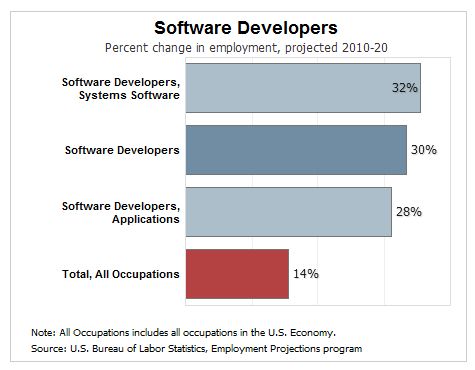Use What You Know
Taking a look at your skills and understanding how they match up with what employers want is a first step toward making a big change. To find software developer jobs, click here. If you have strong computer-science fundamentals, for example, you understand how data structures and algorithms work—something that becomes invaluable when discussing your potential worth with an employer in a new sub-industry. “For instance, if one is writing algorithms as a quant developer, it may translate well for writing algorithms in AdTek,” Schade added.Portable Skill Sets
While recruiters and management may first seek out candidates trained in a specific platform, those potential hires aren’t always the best fit for the position. David Yang, placement coordinator and lead instructor at the Fullstack Academy of Code in New York, suggests that developer skill sets are often portable across many different domains. “Every industry large and small is being transformed by technology,” he said. “The key thing you have to be cognizant of in making a switch is considering the business domain of the industry you want to go into, and understanding how technology fits into that domain.”Identity the Field
In some business sectors, domain-specific experience is critical, e.g. financial services and healthcare, because of their security and compliance mandates… But even those fields can be cracked. “As you begin to identify that you want to make an industry shift and decide where that might be,” Schade said, “take a look at the job descriptions to see what companies are requiring. If there are certain things that you don’t have, ask yourself if you can build those things elsewhere before you begin applying.”Study the Industry
Candidates who want to make the jump must realize that the jargon, language, and technology stack in their targeted sub-industry could be radically different from anything they’ve experienced before; knowing key players is often the best way to get started. “For example,” Yang said, “if you want to go from retail to healthcare, there will be new regulations that you've never had to deal with. HIPAA alone prescribes a whole set of recommended data transmission and storage regulations.” He recommends that job seekers start with Meetups and get an introduction to the business by listening to other members’ discussions. Don’t be afraid to ask a lot of questions, and make a point of learning the technology. “For instance," he added, “the Web 2.0 world consistently uses open-source software but other industries usually have powerful incumbents.”Prove Your Worth
When it comes to proving you have proficiency in a new technology, experience deficits can often be overcome with side projects. “Let’s say it’s a Java developer position in financial services and you’ve been in Web development in e-commerce,” Schade said. “You should show that you have strong Java object-oriented skills by demonstrating your code through a GitHub account or other project. If they want more, offer to take a test to corroborate your abilities.”Benefits of Being a N00B
For employers, there are perks to hiring candidates who’ve left one industry for another. Doing so shows that you’re highly motivated, can navigate complex change, are flexible, and have an abiding interest in that field.Upload Your ResumeEmployers want candidates like you. Upload your resume. Show them you're awesome.
Related Articles
- For Software Developers, Key to Retention Isn’t Just Money
- Software Developers Feel Growing Power
- A Gentle Rant About Software Development and Installers



